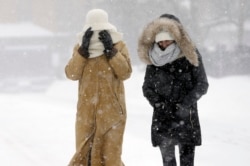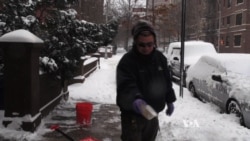A powerful winter storm dropped as much as 60 centimeters (almost 2 feet) of snow in some parts of the northeastern U.S. on Monday and Tuesday, leaving millions of residents stranded in their homes waiting for the weather to break.
Boston and surrounding New England got the brunt of the storm, as near-record snowfall and high winds caused blizzard conditions. Storm-driven flooding added to the woes of those who live in coastal areas.
In one Massachusetts seaside town, Marshfield, 50 kilometers (31 miles) south of Boston, high tides breached a seawall, damaging several homes and prompting officials to urge that residents evacuate.
The island of Nantucket, with about 10,000 full-time residents, lost all electrical power for several hours during the storm. By Tuesday night, the local police chief said, power had been restored to much of the island. At one point, reported winds on Nantucket reached 126 kilometers (78 miles) per hour.
Some forecasts miss mark
The northeastern states of Massachusetts, Rhode Island and Connecticut got some of the heaviest snow. But the storm fell short of forecasters' worst predictions farther south in New York and New Jersey. The governors of those two states began lifting travel bans after dawn Tuesday, while the National Weather Service canceled its blizzard warning for New York City.
"This is nothing like we feared it would be," New York City Mayor Bill de Blasio told CNN. De Blasio had earlier warned the storm could be one of the worst the city had ever faced.
In Manhattan's largely deserted Times Square, residents were underwhelmed.
"I was expecting 2 feet [60 cm], and it's only like a couple of inches [5 cm]," said New York resident Allison Tiberie. "So they're making a big deal out of nothing. I didn't think it was that bad."
New York state's governor, Andrew Cuomo, defended the decision to implement the travel bans, saying it was better to be safe than sorry.
 Pedestrians walk bundled against the blowing snow during a winter snowstorm, Tuesday, Jan. 27, 2015, in Boston.
Pedestrians walk bundled against the blowing snow during a winter snowstorm, Tuesday, Jan. 27, 2015, in Boston. "I would rather, if there's a lean one way or another, if you will, lean toward safety," he said. "Because I've seen the consequences the other way, and it gets very frightening, very quickly. And I've seen people put in extraordinarily dangerous situations, and we've had people die in storms."
The New York Stock Exchange was operating normally Tuesday, but United Nations headquarters and many schools and businesses across the Northeast were closed.
Thousands of flights across the region were canceled, according to FlightAware.com. The blizzard had a ripple effect on travelers and airports all across the U.S. As far south as Atlanta's Hartsfield-Jackson airport, more than 50 flights were canceled.
The only reported death in the storm occurred on New York's Long Island, which was hit much harder than Manhattan. The victim was a teenager who crashed into a light post while snow tubing.
Washington escapes blizzard
The brunt of the storm missed the nation's capital, which saw only light snow mixed with rain, but federal offices and public schools in the city opened two hours late Tuesday to give people extra travel time.
On social media, Americans waiting out the snowstorm posted photos and videos of their cities blanketed in white. Hashtags such as #blizzardof2015 and #Snowmageddon2015 quickly gained traction.
Snow was expected to fall over parts of the Northeast through Wednesday morning. Massachusetts Governor Charlie Baker urged residents to stay off the roads.
"If you don't need to go out, I think those folks who are still in the process of cleaning up would appreciate it if you gave them the room and the opportunity to do that," he said.
VOA's William Gallo contributed to this report from Washington. Some information came from AP, Reuters and AFP.








